KöMaL Problems in Physics, January 2023
Please read the rules of the competition.
Show/hide problems of signs:
 |
Problems with sign 'M'Deadline expired on February 15, 2023. |
M. 419. Cut out approximately 2 cm wide strips from a sheet of A4 copy paper, parallel to its longer and to its shorter side. Narrow the middle third of the paper strips along the curved lines as shown in the figure. Measure the tensile strength of the paper. (Express the tensile strength in MPa units). Is there a difference between the tensile strength of the longer and shorter strips?

(6 pont)
 |
Problems with sign 'G'Deadline expired on February 15, 2023. |
G. 801. Two men, each having a mass of 72 kg, are standing on skis on the horizontal ground. The pressure exerted on the snow by the first man is 0.02 bar, and the pressure exerted by the second one is 0.05 bar. The second man is also carrying a 5 kg backpack on his back.
\(\displaystyle a)\) What is the surface area of the skis, which is in contact with the snow?
\(\displaystyle b)\) What will the pressure exerted by the second man be if he drops his backpack and stands on one leg only?
(3 pont)
solution (in Hungarian), statistics
G. 802. Approximately how many minutes later does the solar noon happen in Sopron than in Mátészalka?
(3 pont)
solution (in Hungarian), statistics
G. 803. The speed of an object travelling in a straight line with constant deceleration decreases to half of its initial value when it reaches the end of a straight path. What percentage of its initial speed is lost when it reaches the midpoint of the path?
(4 pont)
solution (in Hungarian), statistics
G. 804. A wooden block of density \(\displaystyle 0.6 \mathrm{kg/dm}^3\) is floating in a large pool. It has a height of 40 cm, the length of its base is 80 cm and the width of its base is 30 cm. The block is fixed to the bottom of the pool by a spring, having an unstretched length of 50 cm, as shown in the figure.
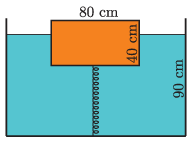
\(\displaystyle a)\) What is the height of that part of the block, which is not under the water if the depth of the water is 90 cm and the spring constant of the spring is 1440 N/m?
\(\displaystyle b)\) At least how much work is required to raise the block completely above the surface of the water if the spring does not break?
(4 pont)
 |
Problems with sign 'P'Deadline expired on February 15, 2023. |
P. 5454. After repairing the tires of cars, the wheels have to be balanced. The wheels are placed to a balancing machine which spins them at very high speed, and measures the imbalance of the wheel. Then small wheel weights are mounted to the appropriate positions in order to balance the wheel. A wheel is rotated at a constant angular acceleration from rest. At a certain moment the speed of the valve cap, which is at a distance of \(\displaystyle R=20\) cm from the axle, is \(\displaystyle v=1\) m/s, and its acceleration is twice as big as it was when the wheel was started to move.
\(\displaystyle a)\) How much time elapsed from the start?
\(\displaystyle b)\) What was the acceleration of the valve cap, at the start of the rotation?
\(\displaystyle c)\) How much distance did the valve cap cover during its rotation?
(4 pont)
solution (in Hungarian), statistics
P. 5455. A point-like object is given an initial horizontal velocity of magnitude \(\displaystyle v_0\) and is placed to the inner surface of a frictionless funnel, 10 cm from the symmetry axis of the funnel. The symmetry axis of the funnel is vertical and the angle between the symmetry axis and the wall of the funnel is \(\displaystyle 45^\circ\). What will the greatest speed of the object be if
\(\displaystyle a)\) \(\displaystyle v_0= 0.5\) m/s;
\(\displaystyle b)\) \(\displaystyle v_0= 2.0\) m/s?
(5 pont)
solution (in Hungarian), statistics
P. 5456. In the picture, you can see workers rolling up a well ring to a lorry along the planks (or they may also roll down the ring, along the planks). The weight of the well ring is 300 kg, the diameter is 1 m, the length of the planks is 5 m, and the height of the lorry platform is 1 m. Assume that the net force exerted by the workers' hands is parallel to the planks, the coefficient of friction between their hands and the well ring is 0.8, and that the well ring does not slide on the plank.
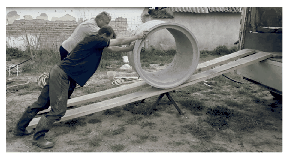
Determine the minimum force that must be exerted on the concrete well ring parallel to the planks if it is to roll uniformly, without slipping
\(\displaystyle a)\) upward;
\(\displaystyle b)\) downward.
(5 pont)
solution (in Hungarian), statistics
P. 5457. The internal length of a thermally insulated cylindrical tank is \(\displaystyle L\). The container is divided into two parts by an insulating piston; the left part contains a sample of monatomic ideal gas, and there is vacuum in the right part (see the figure). The piston is connected to the right end of the tank by spring, whose unextended length is \(\displaystyle L\). The gas is slowly heated by an electric heating element in the left half of the cylinder.
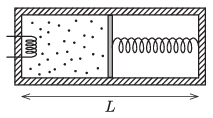
Determine the molar heat of the gas in this process.
(5 pont)
solution (in Hungarian), statistics
P. 5458. Three batteries have the same electromotive force of 12 V and each of them has an internal resistance of 3 \(\displaystyle \Omega\). How should the batteries be connected in order that we obtain the maximum power dissipated in the external resistance \(\displaystyle R\), and what is this power if
\(\displaystyle a)\) \(\displaystyle R = 1 \Omega\);
\(\displaystyle b)\) \(\displaystyle R = 3 \Omega\);
\(\displaystyle c)\) \(\displaystyle R = 3.5 \Omega\);
\(\displaystyle d)\) \(\displaystyle R = 6 \Omega\)?
(4 pont)
solution (in Hungarian), statistics
P. 5459. A piece of wire, whose thickness is the same everywhere, is bent into a circle of radius \(\displaystyle R\). At one point of the circle, a current of magnitude \(\displaystyle I\) flows into the wire in ``radial direction'' and at another point (also in the radial direction) it flows out of the wire.
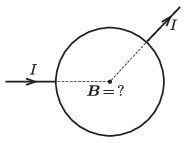
What is the direction and the magnitude of the magnetic induction at the centre of the circle?
(3 pont)
solution (in Hungarian), statistics
P. 5460. Coloured perfume is marketed in cylindrical bottles with an outer diameter of 4 cm, and a height of 10 cm. The thickness of the wall of the bottle is constant and its material has a refractive index of \(\displaystyle n=1.5\). The perfume is placed on the shelf at eye level and backlit. Distant customers see the cylinder as having a wall thickness of zero (the photograph is for illustration purposes only, the shape of the bottle and the wall thickness are different from those described in the exercise). At least how many ml of perfume can be in the bottle?
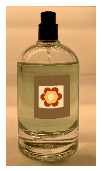
(4 pont)
solution (in Hungarian), statistics
P. 5461. The \(\displaystyle {}^{40}\mathrm{K}\) isotope is not produced by the decay of other elements, so its quantity on the Earth has halved every 1.25 billion years since the Earth was formed. The \(\displaystyle {}^{40}\mathrm{K}\) decays by electron capture or by \(\displaystyle \beta^+\) decay (11%) and by \(\displaystyle \beta^{-}\) decay (89%).
\(\displaystyle a)\) What nuclei are produced in each radioactive process?
\(\displaystyle b)\) One of the decay products is gaseous and does not escape after a rock solidifies. Analysing this rock sample, it was found that the amount of gas produced was 90% of the \(\displaystyle {}^{40}\mathrm{K}\) that was still present. How long ago did the rock solidify?
(4 pont)
solution (in Hungarian), statistics
P. 5462. A long rod is attached to a spring of negligible mass. If the spring is suspended by the other end, its elongation will be \(\displaystyle s=15\) cm. Then the spring and the rod are placed on a horizontal, frictionless surface and the free end of the spring is fixed. The rod is pulled back by a distance of \(\displaystyle \ell\) as shown in the figure, so the spring will be stretched. Finally, a cube-shaped body is placed on the top face of the rod, at that end of the rod which is closer to the spring. The coefficient of friction (both static and dynamic) between the rod and the cube is \(\displaystyle \mu=0.2\).
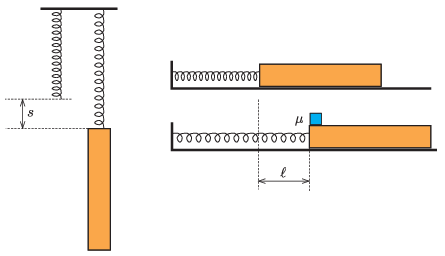
When the rod is released, the system starts to move and the cube slides on the rod. The sliding between the two bodies ceases after the moment when the acceleration of the cube becomes zero.
\(\displaystyle a)\) How long did the cube slide on the rod?
\(\displaystyle b)\) What is the least distance of \(\displaystyle \ell\) in order that the above described motion could occur?
\(\displaystyle c)\) How much distance did the cube slide along the rod?
(6 pont)
Upload your solutions above.
